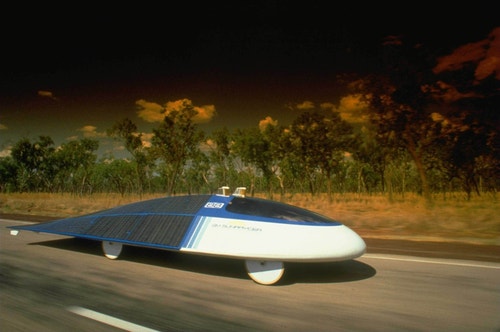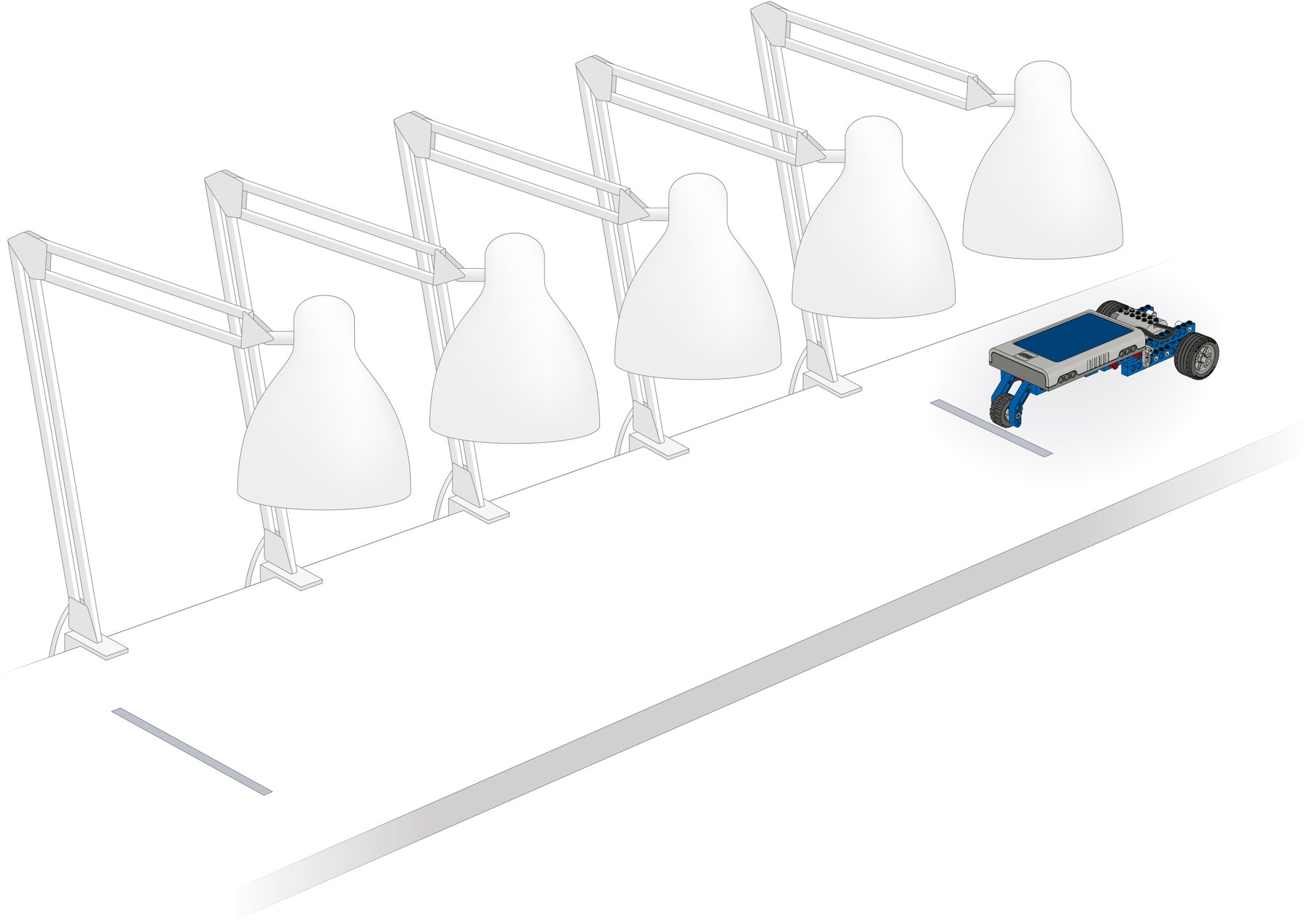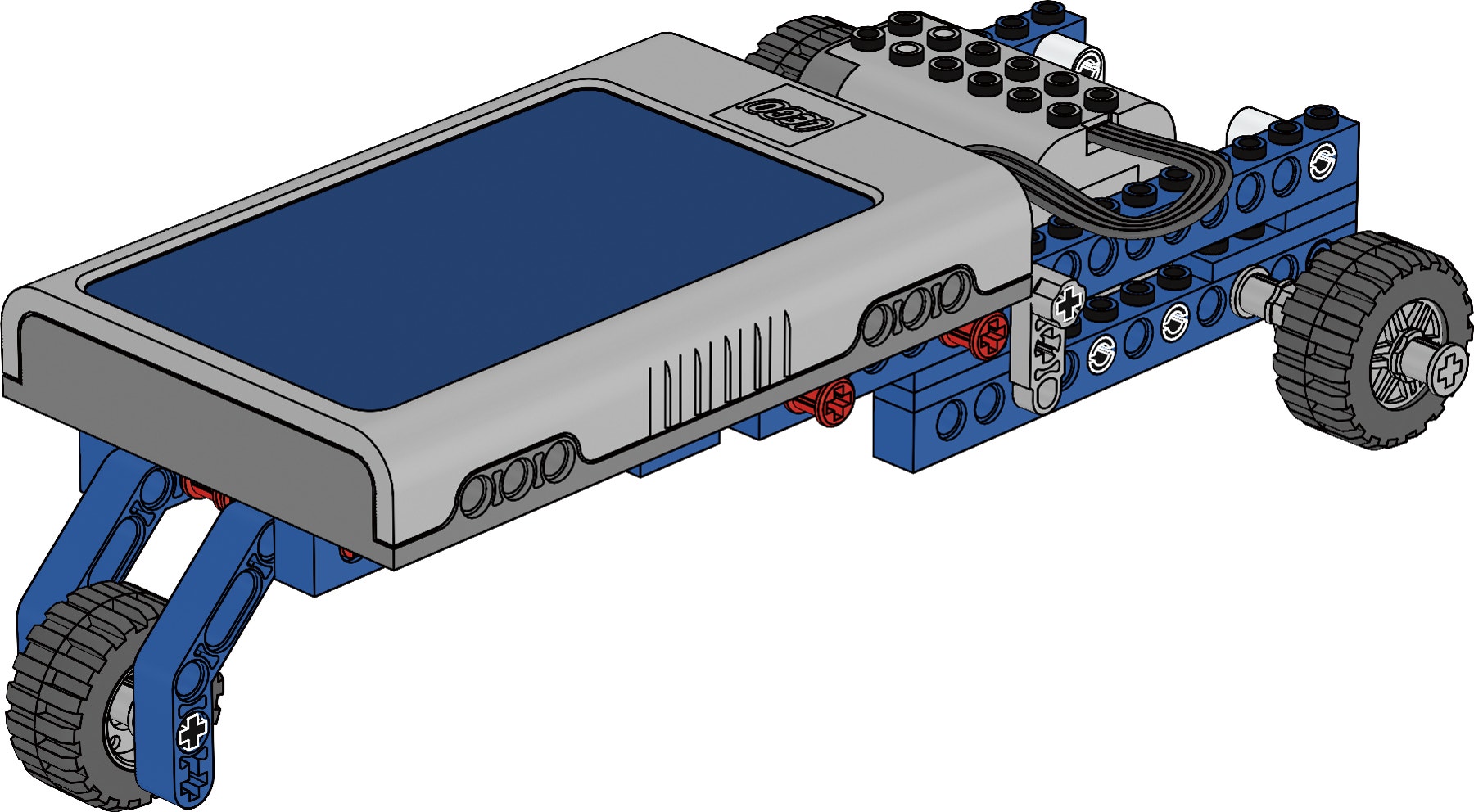Solar Vehicle
Explore transfer, transformation, storage and dissipation of energy with reference to conversion of solar energy to electrical energy

Connect
(5-10 Minutes)
Solar vehicles use the ability of solar panels to convert solar energy into electrical energy. The motor has the ability to convert electrical energy into mechanical energy and move the vehicle.
Now build the Solar Vehicle and investigate its speed with different gear ratios and wheel size.

Construct
(20-25 Minutes)
Build the Solar Vehicle
(Building Instruction booklet 5A and 5B, to page 38, step 24).
Test the model’s functionality. Loosening bushings can reduce friction. Connect the plugs properly by pressing them firmly together.

Test Setting
Position the LEGO® Solar Panel at an adequate distance from the light source. A 60 W incandescent light bulb, high performance halogen emitters or any other
light source that emits a high amount of IR spectra > 800 nm. Place the Solar Panel under the center of the light source. Optimally the lamps diameter should cover the LEGO Solar Panel and have a parabolic reflector.
To set up an illuminated test track, place several identical light bulbs / lamps at the same height above the 100 cm (= 40 in.) test track.
To help students measure the distance of the bulb in the lamp to the Solar Panel, it is helpful to make a mark on the lamp casing, level with the center of the light bulb.
Mark a start line and finish line 100 cm (= 40 in.) apart on a smooth flat surface. Students can gently push the Solar Vehicle forward to get it started if needed.


Warning! This may be dangerous!
Warning!
Heat can damage the Solar Panel. Keep a distance of at least 8 cm (= 3 in.) from the Solar Panel to the light source at all times.
Make sure students handle light bulbs with great care!
Contemplate
(20-25 minutes)
Traveling with different gear ratios
The task requires students to investigate the speed of the Solar Vehicle traveling the track with different gearings and two large rear wheels.

First, have students predict with which speed the Solar Vehicle will travel the track with a gearing of 5:1.
Then, have students investigate the speed of the Solar Vehicle traveling the track with a gearing of 5:1. Calculate the speed and record your findings. Use this formula, where speed is measured in meters per second:
** Distance traveled
Speed = Time taken**
Findings will vary depending on the light source and the influence of friction.
Next, rebuild the Solar Vehicle and have students follow the same procedure for the new Solar Vehicle with a gearing of 3:1. (Building Instruction booklet 5A and 5B, to page 42, step 4).
Findings will vary, students will see that the Solar Vehicle with a gearing of 3:1, travels fastest.
Have students reflect on their investigations by asking questions such as:
• Which factors did you base your predictions on?
• Can you explain your findings?
• Can you identify a pattern or trend in the findings?
The 3:1 gearing travels fastest because of the gear ratio.
• How did you make sure that your findings were scientifically valid?
Students need to investigate several times to make sure findings are consistent and that the Solar Panel stays in the same position and at the same distance from the light source.
Did you know?
Gear ratio can be found by comparing the number of teeth on the gears.
Continue
(25-30 Minutes)
Traveling with smaller wheels
(Building Instruction booklet 5A and 5B, to page 44 step 6).
The task requires students to investigate the speed of the Solar Vehicle traveling the track with a gearing of 3:1 and with two small rear wheels.

First, have students predict with which speed the Solar Vehicle will travel the track with a gearing of 3:1 and three identical small wheels.
Then, have students investigate the speed of the Solar Vehicle traveling the track with a gearing of 3:1 and three identical small wheels. Calculate the speed and record your findings.
Findings will vary depending on the light source and friction.
Next, have students look carefully at their findings and compare this new arrangement of the Solar Vehicle to the prior test findings, where the Solar Vehicle had a 3:1 gearing and two larger rear wheels.
Findings will vary, but the Solar Vehicle with the large rear wheels will travel the distance fastest, even though the axel speed is the same, due to the larger circumference of the larger wheels.
Identifying variables
Have students identify and write down at least three variables, explaining clearly how these affect the Solar Vehicle’s efficiency.
Some factors could include the effects of changing the amount of light on the Solar Panel, friction, wheel diameter, balance and changing the weight of the Solar Vehicle.
Optional
Have students optimize conditions for the Solar Vehicle.
Did you know?
The circumference of the small wheel is 9.6 cm (= 3 3/4 in.).
The circumference of the large wheel is 13.6 cm (= 5 3/8 in.).
Teacher Support
Students will explore the concepts of:
Scientific investigation
Conversion and storage of energy
Investigating and evaluating variables
Informal and formal measuring of distance/time/speed/work
Reading, predicting, and interpreting data
9686 Simple & Powered Machines Set (two students per set recommended)
9688 Renewable Energy Add-on Set
A smooth flat track surface at least 150 cm (=5 ft.) long
A 60W incandescent light bulb, high performance halogen emitters or any other light source that emits a high amount of IR spectra > 800 nm
Lamp with parabolic reflectors
Masking tape and marker for start and stop line
Ruler or measuring tape
Stopwatch or timer
NGSS
Disciplinary Core Ideas: Physical Science
MS-PS3 Energy
Crosscutting Concepts
Cause and effect: Mechanism and explanation
Scale, proportion, and quantity
Systems and system models
Energy and matter: Flows, cycles, and conservation
Structure and Function
Stability and change
Science and Engineering Practices
Asking questions and Defining Problems
Developing and using models
Planning and carrying out investigations
Analyzing and interpreting data
Using mathematics, Informational and Computer Technology, and computational thinking
Constructing explanations and designing solutions
Obtaining, evaluating, and communicating information
Common Core State Standards English Language Arts
7.EE.B / 8.EE.C / SL 6-8.1 / SL 6-8.4 / RST 6-8.3 / RST 6-8.4 / RST 6-8.7 / WHST 6-8.1 / WHST 6-8.2 / WHST 6-8.4
Student Material
Share with:
 Google Classroom
Google Classroom



